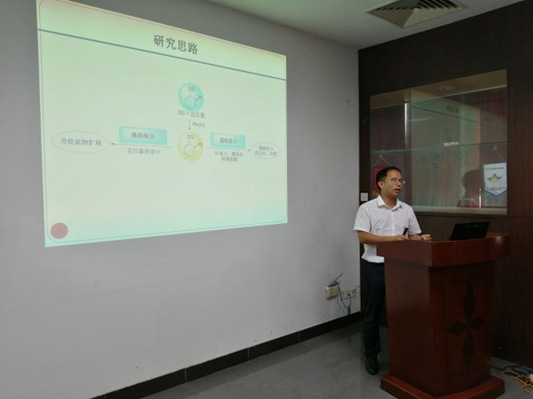On the morning of June 13th, South China University of Technology Outstanding Young Scholars Forum at Home and Abroad Sub-forum of the School of Environment and Energy was successfully held in the conference room B4-308 of the Higher Education Mega Center Campus. This forum had invited Dr. Wang Yi, Staff Scientist from the institute of the Solid-State Research, Max Planck Institute, Germany and post doctor Dr. Qi Zisong from Colorado State University to give academic reports. The head of the School of Environment and Energy and related teachers and students attended this activity.
Dr. Wang Yi made and academic report on the theme of “Understanding the Structure of Materials Atom-by-Atom”. Dr. Wang pointed out that the successful implementation of spherical aberration correction has led to the long-term development of transmission electron microscopy technology, which makes it be qualified with the abilities of detection of atomic structure, element types and chemical bonds between atoms in sub-spatial resolution (<1 Å). In this report, Dr. Wang introduced 1) high-precision quantitative analysis based on atomic resolution images, and technical research work of correction of scan sample drift and image distortion in atomic-resolution STEM-EELS/EDX mapping, and improvement of signal-to-noise ratio of electron energy loss spectrum signals; 2) and the application of these technologies in the research of III-V semiconductors, Calcium mineral oxide films and nano energy materials.

Dr. Qi Zisong gave an academic report on the topic of “Trivalent Ir/ Ru Catalyzed Hydrocarbon Activation of Aromatic Hydrocarbons with Coupling Reaction of Unsaturated Molecules and Nucleophiles”. He pointed out that two major difficulties in the activation of carbon-hydrogen bonds: reactivity and selectivity. In order to solve these problems, especially the problem of selectivity, it is currently mainly achieved by intramolecular reaction or introduction of a guiding group. Based on this, a series of new systems for hydrocarbon activation/ coupling have been developed. For example, the activation of aromatic carbon-hydrogen bonds and the ring-opening coupling reaction of bridged rings are realized. The polarity reversal strategy is used to realize the nitration and alkynylation of aromatic hydrocarbons under mild conditions by hydrocarbon activation mechanism. The tension ring and inorganic salt are introduced into the hydrocarbon activation reaction system as coupling components, which realizes the fusion of carbon-hydrogen bonds and other important fields. At the same time, the concept of multi-functional positioning base is also proposed, which overcomes the limitation of single positioning base with strong scientific significance and potential application value.

The whole forum was permeated with a strong academic exchange atmosphere. The teachers and students conducted a further discussion with the reporters on the research direction and problems respectively, which led to an active atmosphere. Through this platform, we know the latest research results and research trends in the research field, reflecting the latest developments in these areas.
It is reported that the “Outstanding Young Scholars Forum at Home and Abroad” of South China University of Technology aims to invite young talents at home and abroad to develop exploration and exchange around the frontiers and hotspots of international scientific research, as well as the key technical issues of the industry, which provides an opportunity for mutual enlightenment, broadening horizons and promoting international exchanges and cooperation.
Attachment: Introduction to the reporters
Wang Yi, Institute of Solid State, Max Planck Institute, Germany - Stuttgart Electron Microscope Center as Staff Scientist. He obtained a bachelor's degree in physics, a master's degree in materials from Hubei University in 2006 and 2009, and Ph.D. in physics in the French National Science Research Center in 2012 - Lower Normandy The University of Caen. He has been engaged in postdoctoral research at the French National Scientific Research Center and the Solid Institute of the Max Planck Institute of Germany. His research direction is spherical aberration correction (scanning) transmission electron microscopy, atomic resolved electron energy loss spectrum, and its application in functional materials research. He has published more than 60 SCI papers in Ultramicroscopy, ACS Appl. Mater. Interfaces, Appl. Phys. Lett. In 2012, he won the China National Outstanding Self-Financed International Student Award. In 2017, he was selected as a B-Technology Talent in the 100th National Academy of Sciences.
Qi Zisong graduated from the Dalian Institute of Chemical Physics & Dalian University of Technology in December 2015, and later worked as a postdoctoral researcher at the Hong Kong University of Science and Technology. His Postdoctoral research is currently taking place at Colorado State University. Dr. Qi has been engaged in transition metal catalysis and small molecule activation for a long time and has achieved a series of academic innovations. Dr. Qi has published 33 academic papers in international journals such as JACS, Angew. Chem. Int. Ed, Organic Letters, and Chemical Communications, with a total of more than 1,800 references, h-index 24.